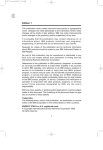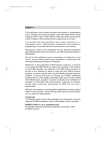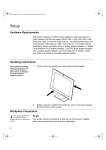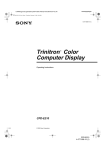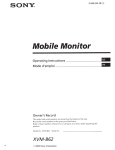Download IBM P275 User's Manual
Transcript
Color Monitor P275 Operating Instructions English Edition 1 This publication could contain technical inaccuracies or typographical errors. Changes are made periodically to the information herein; these changes will be made in later editions. IBM may make improvements and/or changes in the product(s) and/or program(s) at any time. It is possible that this publication may contain reference to, or information about, IBM products (machines and programs), programming, or services that are not announced in your country. Requests for copies of this publication and for technical information about IBM products should be made to your IBM Authorized Dealer or IBM Retailer. No part of this publication may be reproduced or distributed in any form or by any means without prior permission in writing from the International Business Machines Corporation. References in this publication to IBM products, programs, or services do not imply that IBM intends to make these available in all countries in which IBM operates. Any reference to an IBM product, program or service is not intended to state or imply that only IBM’s product, program, or service may be used. Any functionally equivalent product, program, or service that does not infringe any of IBM’s intellectual property rights or other legally protectable rights may be used instead of the IBM product, program, or service. Evaluation and verification of operation in conjunction with other products, programs, or services, except those expressly designated by IBM, are the user’s responsibility. IBM may have patents or pending patent applications covering subject matter in this document. The furnishing of this document does not give you any license to these patents. Trademarks The following terms, used in this publication, are trademarks or service marks of the IBM Corporation in the United States or other countries: IBM HelpCenter • • • • • • ENERGY STAR® is a U.S. registered mark. Trinitron® is a registered trademark of Sony Corporation. DDC™ is a trademark of the Video Electronics Standard Association. VESA is a trademark of Video Electronics Standard Association. All other product names mentioned herein may be the trademarks or registered trademarks of their respective companies. Furthermore, “™” and “®” are not mentioned in each case in this manual. © Copyright International Business Machines Corporation 2001. All rights reserved. International Business Machines Corporation New Orchard Road, Armonk, NY 10504 Note to U.S. Government Users--Documentation related to restricted rights--Use, duplication, or disclosure is subject to restrictions set forth in GSA ADP Schedule Contract with IBM Corp. US Table of Contents Precautions . . . . . . . . . . . . . . . . . . . . . . . . . . . . . . . . . . . . . . . . . . . 2 Identifying parts and controls . . . . . . . . . . . . . . . . . . . . . . . . . . . . . . 3 Setup. . . . . . . . . . . . . . . . . . . . . . . . . . . . . . . . . . . . . . . . . .4 Step 1: Connect your monitor to your computer . . . . . . . . . . . . . . . Step 2: Connect the power cord . . . . . . . . . . . . . . . . . . . . . . . . . . . Step 3: Turn on the monitor and computer . . . . . . . . . . . . . . . . . . . Selecting the input signal . . . . . . . . . . . . . . . . . . . . . . . . . . . . . . . . . 4 5 5 6 Customizing Your Monitor . . . . . . . . . . . . . . . . . . . . . . . .6 Navigating the menu . . . . . . . . . . . . . . . . . . . . . . . . . . . . . . . . . . . . 6 Adjusting the brightness and contrast (CONTRAST/BRIGHT) . . . . 8 Adjusting the centering of the picture (SIZE/CENTER) . . . . . . . . . . 9 Adjusting the size of the picture (SIZE/CENTER) . . . . . . . . . . . . . . 9 Automatically sizing and centering the picture (AUTO) . . . . . . . . . . 9 Adjusting the shape of the picture (GEOMETRY) . . . . . . . . . . . . . 10 Adjusting the convergence (CONVERGENCE) . . . . . . . . . . . . . . . 10 Adjusting the picture quality (SCREEN) . . . . . . . . . . . . . . . . . . . . . 11 Adjusting the color of the picture (COLOR) . . . . . . . . . . . . . . . . . . 12 Additional settings (OPTION) . . . . . . . . . . . . . . . . . . . . . . . . . . . . . 14 Resetting the adjustments (RESET) . . . . . . . . . . . . . . . . . . . . . . . 14 Technical Features . . . . . . . . . . . . . . . . . . . . . . . . . . . . .15 Preset and user modes . . . . . . . . . . . . . . . . . . . . . . . . . . . . . . . . . 15 Power saving function . . . . . . . . . . . . . . . . . . . . . . . . . . . . . . . . . . 15 Troubleshooting. . . . . . . . . . . . . . . . . . . . . . . . . . . . . . . .15 If thin lines appear on your screen (damper wires) . . . . . . . . . . . . On-screen messages . . . . . . . . . . . . . . . . . . . . . . . . . . . . . . . . . . . Trouble symptoms and remedies . . . . . . . . . . . . . . . . . . . . . . . . . . Self-diagnosis function . . . . . . . . . . . . . . . . . . . . . . . . . . . . . . . . . . 15 15 17 19 Specifications. . . . . . . . . . . . . . . . . . . . . . . . . . . . . . . . . .19 Service Information . . . . . . . . . . . . . . . . . . . . . . . . . . . . .21 1 US Use of the Tilt-Swivel Precautions This monitor can be adjusted within the angles shown below. To find the center of the monitor’s turning radius, align the center of the monitor’s screen with the centering mark on the stand. Hold the monitor at the bottom with both hands when you turn it horizontally or vertically. Be careful not to pinch your fingers at the back of the monitor when you tilt the monitor up vertically. Installation Do not install the monitor in the following places: • on surfaces (rugs, blankets, etc.) or near materials (curtains, draperies, etc.) that may block the ventilation holes • near heat sources such as radiators or air ducts, or in a place subject to direct sunlight • in a place subject to severe temperature changes • in a place subject to mechanical vibration or shock • on an unstable surface • near equipment which generates magnetism, such as a transformer or high voltage power lines • near or on a magnetically charged metal surface. • in a small space around the top, bottom and sides of the monitor that may block the ventilation holes. 90° 15° 90° 5° Maintenance Centering mark • Clean the cabinet, panel and controls with a soft cloth lightly moistened with a mild detergent solution. Do not use any type of abrasive pad, scouring powder, or solvent, such as alcohol or benzine. • Do not rub, touch, or tap the surface of the screen with sharp or abrasive items such as a ballpoint pen or screwdriver. This type of contact may result in a scratched picture tube. • Clean the screen with a soft cloth. If you use a glass cleaning liquid, do not use any type of cleaner containing an anti-static solution or similar additive as this may scratch the screen’s coating. Note Do not remove the tilt-swivel base from the monitor. Warning on power connection • Use an appropriate power cord for your local power supply. Example of plug types: US Transportation for 100 to 120 V AC When you transport this monitor for repair or shipment, use the original carton and packing materials. for 200 to 240 V AC for 240 V AC only • Before disconnecting the power cord, wait at least 30 seconds after turning off the power to allow the static electricity on the CRT display surface to discharge. • After the power has been turned on, the CRT is demagnetized (degaussed) for a few seconds. This generates a strong magnetic field around the metal frame, which may affect the data stored on magnetic tapes and disks near the bezel. Place magnetic recording equipment, tapes, and disks away from this monitor. The equipment should be installed near an easily accessible electrical outlet. 2 Identifying parts and controls See the pages in parentheses for further details. Front Rear AC IN 1 (input) switch (page 6) This switch selects 1 (video input connector 1: 1 (video input connector 2: 2 ). 6 AC input connector (page 5) This connector provides AC power to the monitor. ) or 2 7 Video input connector 1 (HD15) (1 ) (page 4) Inputs RGB video signals (0.700 Vp-p, positive) and sync signals. 2 6m(contrast/down) and M (brightness/up) buttons (pages 6 – 14) These buttons are used to display the CONTRAST/BRIGHT menu and to highlight the desired menu item. 3 5 4 3 2 1 10 9 8 7 6 15 14 13 12 11 button (pages 6 – 14) This button is used to display the menu and to select the menu item and to activated the adjustment. 4 </, buttons (pages 6 – 14) These buttons are used to make the adjustment. 5 ! (power) button and indicator (pages 5, 15, 17, 19) This button turns the monitor on and off. The power indicator lights up in green when the monitor is turned on, and lights up in orange when the monitor is in power saving mode. Pin No. Signal Pin No. Signal 1 Red 8 Blue Ground 2 Green (Sync on Green) 9 DDC + 5V* 10 Ground 11 ID (Ground) 12 Bi-Directional Data (SDA)* 3 Blue 4 ID (Ground) 5 DDC Ground* 13 H. Sync 6 Red Ground 14 V. Sync 7 Green Ground 15 Data Clock (SCL)* * Display Data Channel (DDC) Standard of VESA (continued) 3 US Rear Setup This monitor works with platforms running at horizontal frequencies between 30 and 130 kHz. Step 1: Connect your monitor to your computer AC IN Turn off the monitor and computer before connecting. Connect the appropriate end of the video signal cable to the video output of your computer. Connect the other end of the video signal cable to the appropriate input of the monitor. If you attach the video signal cable to the video input connector 1 on the back of the monitor, set the (input) switch on the front of the monitor to 1. 8 Video input connector 2 (DVI) (2 ) (page 4) Inputs RGB video and sync signals (0.700 Vp-p, positive) through a DVI-A connector. C4 C3 C2 C1 C5 Pin No. Notes • Do not touch the pins of the video signal cable connector as this might bend the pins. • When connecting the video signal cable, check the alignment of the video input connector. Do not force the video input connector in the wrong way or the pins might bend. 24 23 22 21 20 19 18 17 16 15 14 13 12 11 10 9 8 7 6 5 4 3 2 1 Signal Pin No. To a computer with an HD15 video output Signal C1 Red 10 — C2 Green 11 — C3 Blue 12 — C4 H. Sync 13 — C5 Ground (R/G/B) 14 DDC + 5V* 1 — 15 Ground 2 — 16 Hot Plug Detect 3 — 17 — 4 — 18 — 5 — 19 — 6 Data Clock(SCL)* 20 — 21 — 7 Bi-Directional Data (SDA)* 22 — 8 V.Sync 23 — 9 — 24 — US forward side backward side AC IN forward side backward side To a computer with a DVI video output * Display Data Channel (DDC) Standard of VESA (continued) 4 Workplace Preparation Step 2: Connect the power cord Positioning the Monitor Choose a suitable place to position the monitor where it is not near fluorescent desk lighting or any equipment that produces magnetic fields that could cause interference. Ensure that the furniture or equipment can support the weight of the monitor. Allow at least 2 inches (50mm) ventilation space around the monitor. With the monitor and computer turned off, first connect the proper power cord for your local supply to the monitor, then connect it to a properly grounded power outlet. Height The monitor should be positioned so that the top of the screen is slightly below your eye level when you sit at your workstation. Orientation Choose a position that gives the least reflection from lights and windows, usually at a right angle to any windows. The monitor should be positioned directly in front of you so that you do not have to twist your body. Tilt the monitor to a comfortable viewing angle. to AC input to a power outlet power cord Working Practices Step 3: Turn on the monitor and computer Rest Take regular breaks. Vary your posture, and stand up and stretch occasionally as prolonged use of computer workstations can be tiring. First turn on the monitor, then turn on the computer. Back You should sit back in the chair and use the backrest. Hands Use a light touch on the keyboard, keeping your hands and fingers relaxed. Allow a space in front of the keyboard to rest your wrists when not typing. Consider using a wristpad. The installation of your monitor is complete. If necessary, use the monitor’s controls to adjust the picture. If no picture appears on your screen Eyesight Working with monitors, in common with any kind of prolonged close work, can be visually demanding. Look away from the screen periodically and have your eyesight checked regularly. • Check that the monitor is correctly connected to the computer. • If NO SIGNAL appears on the screen, try changing the input signal (page 6), and confirm that your computer’s graphics board is completely seated in the correct bus slot. • If you are replacing an old monitor with this model and OUT OF SCAN RANGE appears on the screen, reconnect the old monitor. Then adjust the computer’s graphics board so that the horizontal frequency is between 30 – 130 kHz and the vertical frequency is between 48 – 170 Hz. Screen settings Set the screen brightness and contrast to a comfortable level. You may have to adjust this as the lighting changes during the day. Many application programs let you select color combinations which can help you to view in comfort. For more information about the on-screen messages, see “Trouble symptoms and remedies” on page 17. 5 US Selecting the input signal Customizing Your Monitor You can connect two computers to this monitor using the video input connectors. To select one of the two computers, use the (input) switch. You can make numerous adjustments to your monitor using the on-screen menu. Slide the (input) switch. The selected video input connector appears on the screen for 3 seconds. “INPUT 1” or “INPUT 2” appears on the screen. Navigating the menu x Using the , m/M, and </, buttons 1 Display the menu. Press the button to display the menu on the screen. EX I T CONTRAST b Note If no signal is input to the selected video input connector, NO SIGNAL appears on the screen. After a minute, the monitor enters the power saving mode. If this happens, switch to the other video input connector. 85 1600x1200 / 85Hz 2 Select the menu you want to adjust. Highlight the desired menu by pressing the m/M buttons. Then press the button. US b 3 Adjust the menu. Press the </, buttons to make the adjustment, then press the button to activate the adjustment. b If you want to select another menu: Press the m/M buttons to select and press the exit the menu. button to 4 Close the menu. Each time you select and press the button, the menu exits. If no buttons are pressed, the menu closes automatically after about 30 seconds. (continued) 6 x Selecting the on-screen menu language (LANGUAGE) x Menu items EXIT Close the menu. English, French, German, Spanish, Italian, Dutch, Swedish, Russian, and Japanese versions of the on-screen menus are available. 1 Press the CONTRAST/BRIGHT (page 8) Adjusts the contrast and brightness. You can also call up this menu directly by pressing the 6 m or M buttons while there is no menu on the screen. button. EX I T CONTRAST b 85 SIZE/CENTER (page 9) Adjusts the size or centering. 1600x1200 / 85Hz 2 Press the m/M buttons to highlight press the CONTRAST / BR I GHT CONTRAST 85 1600x1200 / 85Hz S I ZE / CENTER OPTION and button. 45 OPT I ON 1600x1200 / 85Hz CONTROL LOCK b GEOMETRY (page 10) Adjusts the rotation and shape of the picture. ON OFF GEOMETRY 1600x1200 / 85Hz 45 3 Press the m/M buttons to highlight and press the (LANGUAGE) 1600x1200 / 85Hz button. CONVERGENCE (page 10) Adjusts the picture’s horizontal and vertical convergence. OPT I ON b LANGUAGE ENGL I SH FRANÇA I S DEUTSCH 1/3 CONVERGENCE T B 45 1600x1200 / 85Hz 1600x1200 / 85Hz SCREEN (page 11) Adjusts the picture’s quality. The options include: • degaussing the screen (DEGAUSS) • adjusting the moire cancellation (CANCEL MOIRE) • adjusting the landing (LANDING) 4 Press the m/M buttons until the desired language appears on the screen. Then press the button to select the language. Each time you press the m/M buttons, the languages that can be selected appear cyclically. • ENGLISH • FRANÇAIS: French • DEUTSCH: German • ESPAÑOL: Spanish • ITALIANO: Italian • NEDERLANDS: Dutch • SVENSKA: Swedish • : Russian • : Japanese COLOR (page 12) Adjusts the picture’s color temperature to match the monitor’s colors to a printed picture’s colors. To close the menu Press the m/M buttons to select . If no buttons are pressed, the menu closes automatically after about 30 seconds. SCREEN DEGAUSS OK CANCEL 1600x1200 / 85Hz COLOR : PRESET 9300K 6500K 5000K 1600x1200 / 85Hz (continued) 7 US OPTION (page 14) Adjusts the monitor’s options. The options include: • locking the controls • changing the on-screen menu’s language • changing the on-screen menu position • changing the picture’s color temperature setting mode 0 RESET (page 14) Resets the adjustments. Adjusting the brightness and contrast (CONTRAST/BRIGHT) OPT I ON CONTROL LOCK ON OFF These settings are stored in memory for the signals from the currently selected video input connector. 1600x1200 / 85Hz 1 Press the button. The menu appears on the screen. 2 Press the m/M buttons to highlight CONTRAST/ BRIGHT. Then press the button. The CONTRAST/BRIGHT menu appears on the screen. RESET 1 2 3 Press the m/M buttons to highlight 6 (CONTRAST) CURRENT MODE or OK CANCEL (BRIGHTNESS). Then press the button. 4 Press the </, buttons to adjust the contrast (6) or brightness ( 1600x1200 / 85Hz ). If you are using the sRGB mode x Displaying the current input signal When you press the button to display the menu, information on the current input signal is displayed. If the current input signal matches one of the monitor’s factory preset modes, the resolution and vertical frequencies are displayed. (See page 20 for a list of factory preset modes.) If the current input signal does not match one of the factory presets, the horizontal and vertical frequencies are displayed. If you selected the sRGB mode in the COLOR MODE ( ) of the OPTION ( ) menu, the following CONTRAST/BRIGHT menu appears on the screen. CONTRAST / BR I GHT s RGB : US / EX I T 1600x1200 / 85Hz CONTRAST You cannot adjust the contrast (6) or brightness ( ) on this screen. If you want to adjust them, select a mode other than sRGB in the COLOR MODE ( ) of the OPTION ( ) menu. 85 1600x1200 / 85Hz the vertical frequencies of the current input signal For more information about using the sRGB mode, see “Adjusting the color of the picture (COLOR)” on page 12. the resolution or horizontal frequencies of the current input signal 8 Adjusting the centering of the picture (SIZE/CENTER) Automatically sizing and centering the picture (AUTO) This setting is stored in memory for the current input signal. You can easily adjust the picture to fill the screen by using the SIZE/CENTER menu. 1 Press the button. The menu appears on the screen. 1 Press the button. The menu appears on the screen. 2 Press the m/M buttons to highlight SIZE/CENTER and press the button. The SIZE/CENTER menu appears on the screen. 2 Press the m/M buttons to highlight SIZE/CENTER and press the button. The SIZE/CENTER menu appears on the screen. 3 Press the m/M buttons to select for horizontal adjustment, or for vertical adjustment. Then press the button. 3 Press the m/M buttons to select (AUTO). Then press the button. The adjustment window appears on the screen. 4 Press the </, buttons to adjust the centering. 4 Press the m/M buttons to select OK. The picture automatically fills the screen. Adjusting the size of the picture (SIZE/CENTER) This setting is stored in memory for the current input signal. 1 Press the button. The menu appears on the screen. Notes • If you do not want to use the AUTO function, select CANCEL in step 4. • This function is intended to be used when the computer is displaying what should be a full-screen picture. It may not work properly if the background color is dark or if the input picture does not fill the screen to the edges. • The displayed image moves for a few seconds while this function is performed. This is not a malfunction. 2 Press the m/M buttons to highlight SIZE/CENTER and press the button. The SIZE/CENTER menu appears on the screen. 3 Press the m/M buttons to select for horizontal adjustment, or for vertical adjustment. Then press the button. 4 Press the </, buttons to adjust the size. 9 US Adjusting the shape of the picture (GEOMETRY) Adjusting the convergence (CONVERGENCE) The GEOMETRY settings allow you to adjust the rotation and shape of the picture. The (rotation) setting is stored in memory for all input signals. All other settings are stored in memory for the current input signal. The CONVERGENCE settings allow you to adjust the quality of the picture by controlling the convergence. The convergence refers to the alignment of the red, green, and blue color signals. If you see red or blue shadows around letters or lines, adjust the convergence. These settings are stored in memory for all input signals. 1 Press the button. The menu appears on the screen. 1 Press the button. The menu appears on the screen. 2 Press the m/M buttons to highlight GEOMETRY and press the button. The GEOMETRY menu appears on the screen. 2 Press the m/M buttons to highlight CONVERGENCE and press the button. The CONVERGENCE menu appears on the screen. 3 Press the m/M buttons to select the desired 3 Press the m/M buttons to select the desired adjustment item. Then press the button. The adjustment bar appears on the screen. adjustment item. Then press the button. The adjustment bar appears on the screen. 4 Press the </, buttons to make the adjustment. Select 4 Press the </, buttons to make the adjustment. To Select rotate the picture horizontally shift red or blue shadows expand or contract the picture sides vertically shift red or blue shadows shift the picture sides to the left or right adjust the picture width at the top of the screen shift the picture to the left or right at the top of the screen 0 RESET To reset all the GEOMETRY adjustments to the factory setting levels. Select OK. For more information about using the RESET mode, see “Resetting the adjustments (RESET)” on page 14. T TOP vertically shift red or blue shadows at the top of the screen B BOTTOM vertically shift red or blue shadows at the bottom of the screen 0 RESET reset all the CONVERGENCE adjustments to the factory setting levels. Select OK. For more information about using the RESET mode, see “Resetting the adjustments (RESET)” on page 14. 10 US Adjusting the picture quality (SCREEN) Select To DEGAUSS degauss the monitor. To degauss the monitor manually, select OK. The SCREEN settings allow you to degauss (demagnetize) the monitor manually and adjust the picture quality by controlling the moire and landing. • If the color is not uniform or the picture is fuzzy, degauss the monitor (DEGAUSS). • If elliptical or wavy patterns appear on the screen, cancel the moire (CANCEL MOIRE). • If the color is irregular at the corners of the screen, adjust the landing (LANDING). The monitor is automatically demagnetized (degaussed) when the power is turned on. The screen is degaussed for a few seconds. If a second degauss cycle is needed, allow a minimum interval of 20 minutes for the best result. CANCEL MOIRE adjust the degree of moire cancellation until the moire* is at a minimum LANDING reduce any color irregularities in the screen’s top left corner to a minimum LANDING reduce any color irregularities in the screen’s top right corner to a minimum LANDING reduce any color irregularities in the screen’s bottom left corner to a minimum LANDING reduce any color irregularities in the screen’s bottom right corner to a minimum 0 RESET * Moire is a type of natural interference which produces soft, wavy lines on your screen. It may appear due to interference between the pattern of the picture on the screen and the phosphor pitch pattern of the monitor. The CANCEL MOIRE setting is stored in memory for the current input signal. All other settings are stored in memory for all input signals. Example of moire 1 Press the button. The menu appears on the screen. 2 Press the m/M buttons to highlight reset all the SCREEN adjustments to the factory setting levels. Select OK. SCREEN and US press the button. The SCREEN menu appears on the screen. 3 Press the m/M buttons to select the desired Note The picture may become fuzzy when the CANCEL MOIRE function is activated. adjustment item. Then press the button. The adjustment bar appears on the screen. 4 Press the m/M or </, buttons to make the adjustment. 11 x PRESET mode Adjusting the color of the picture (COLOR) 1 Press the button. The menu appears on the screen. The COLOR settings allow you to adjust the picture’s color temperature by changing the color level of the white color field. Colors appear reddish if the temperature is low, and bluish if the temperature is high. This adjustment is useful for matching the monitor’s color to a printed picture’s colors. You can set the color temperature for each of the video input connectors. 2 Press the m/M buttons to highlight COLOR and press the button. The COLOR menu appears on the screen. 3 Press the m/M buttons to highlight the . Then press button. COLOR : PRESET x Select the COLOR mode 9300K 6500K 5000K There are 4 types of adjustment modes, PRESET, VARIABLE, EXPERT, and sRGB. The default setting is PRESET which can be adjusted to 9300K, 6500K, or 5000K. If you want to set another mode (other than PRESET), select the desired mode in the OPTION ( ) menu. Then adjust the selected mode in each COLOR ( ) menu. 1600x1200 / 85Hz 4 Press the m/M buttons to select the desired temperature. The preset color temperatures are 9300K, 6500K, and 5000K. Since the default setting is 9300K, the whites will change from a bluish hue to a reddish hue as the temperature is lowered to 6500K and 5000K. 1 Press the button. The menu appears on the screen. 2 Press the m/M buttons to highlight OPTION and x VARIABLE mode press the button. The OPTION menu appears on the screen. US 1 Press the 3 Press the m/M buttons to highlight MODE). Then press the button. The menu appears on the screen. (COLOR button. 2 Press the m/M buttons to highlight COLOR and press the button. The COLOR menu appears on the screen. 4 Press the m/M buttons to select the COLOR mode. OPT I ON 3 Press the m/M buttons to highlight COLOR MODE the PRESET VARIABLE EXPERT s RGB . Then press button. COLOR : VARIABLE 1600x1200 / 85Hz 5 Press the 5000K button three times to close the menu. 1600x1200 / 85Hz 4 Press the </, buttons to fine tune the color temperature. The new color temperature setting you fine tuned between 5000K to 11000K is stored in memory. (continued) 12 x EXPERT mode Restoring the color from the PRESET, VARIABLE, or sRGB modes (COLOR RETURN) You can make additional adjustments to the color in greater detail by selecting the EXPERT mode. The colors of most display monitors tend to gradually change brilliance over several years of service. The COLOR RETURN feature found in the PRESET, VARIABLE, and sRGB menus allows you to restore the color to the original factory quality levels. The explanation below explains how to restore the monitor’s color from the PRESET mode for example. 1 Press the button. The menu appears on the screen. 2 Press the m/M buttons to highlight press the COLOR and button. COLOR First, select the PRESET, VARIABLE, or sRGB mode in the OPTION menu (page 12). : EXPERT R G B R G B 1 Press the button. The menu appears on the screen. 45 1600x1200 / 85Hz 2 Press the m/M buttons to highlight 3 Press the m/M buttons to select the R (red), G (green), or B (blue) and press the button. Then press the </, buttons to adjust the input signal for both GAIN (6) and BIAS ( ). If you want to reset the EXPERT adjustments, select 0 (RESET) in COLOR menu. Then select OK in the RESET window. 3 Press the m/M buttons to highlight RETURN). Then press the button. x sRGB mode : PRESET COLOR RETURN The sRGB color setting is an industry standard color space protocol designed to correlate the displayed and printed colors of sRGB compliant computer products. To adjust the colors to the sRGB profile, simply select the sRGB mode in the COLOR MODE ( ) menu of the OPTION ( ) menu. However, in order to display the sRGB colors correctly (γ = 2.2, 6500K), you must set your computer to the sRGB profile. If you select this mode, you cannot operate the CONTRAST/BRIGHT menu adjustments. OK CANCEL 1600x1200 / 85Hz The picture disappears while the color is being restored (for a few seconds). After the color is restored, the picture reappears on the screen. Notes • Before using this feature, the monitor must be in normal operation mode (green power indicator on) for at least 30 minutes. If the monitor goes into power saving mode, you must return the monitor to normal operation mode and wait for 30 minutes for the monitor to be ready. You may need to adjust your computer’s power saving settings to keep the monitor in normal operation mode for the full 30 minutes. If the monitor is not ready, the following message will appear. : s RGB s RGB : (COLOR 4 Press the m/M buttons to select OK. COLOR COLOR COLOR and press the button. The COLOR menu appears on the screen. / 1600x1200 / 85Hz COLOR Note Your computer and other connected products (such as a printer), must be sRGB compliant. : PRESET COLOR RETURN AVA I LABLE AFTER WARM UP 1600x1200 / 85Hz • The monitor may gradually lose its ability to perform this function due to the natural aging of the picture tube. 13 US Additional settings (OPTION) Resetting the adjustments (RESET) You can lock the controls, change the on-screen language, change the menu position, and set the COLOR mode. This monitor has the following 2 reset methods. x Resetting all the adjustment data for the current input signal 1 Press the button. The menu appears on the screen. 1 Press the button. The menu appears on the screen. 2 Press the m/M buttons to highlight OPTION and press the button. The OPTION menu appears on the screen. 2 Press the m/M buttons to highlight 0 RESET and press the 3 Press the m/M buttons to select the desired adjustment item. Adjust the selected item according to the following instructions. 3 Press the m/M buttons to select 01 (CURRENT MODE) and press the button. 4 Press the m/M buttons to select OK. x Locking the controls (CONTROL LOCK) RESET You can protect the adjustment data by locking the controls. Press the m/M buttons to highlight (CONTROL LOCK) and press the button. Then press the m/M buttons to select ON and press the button. Only the ! (power) button, button, (input) switch, , and (CONTROL LOCK) of the OPTION menu will operate. If any other items are selected, the mark appears on the screen. To cancel the control lock Repeat the procedure above and set button. 1 2 CURRENT MODE OK CANCEL 1600x1200 / 85Hz Note that the following items are not reset by this method: • on-screen menu language (page 7) • color mode setting in the OPTION menu (PRESET, VARIABLE, EXPERT, sRGB) (page 12) • color temperature setting in the PRESET mode (9300K, 6500K, 5000K) (page 12) • on-screen menu position (page 14) (CONTROL LOCK) to OFF. x Changing the on-screen language (LANGUAGE) See page 7. x Resetting all of the adjustment data for all input signals x Changing the menu’s position (OSD POSITION) Select 02 (ALL MODES) in step 3 above. Change the menu’s position if it is blocking an image on the screen. Press the m/M buttons to select (OSD POSITION) for horizontal adjustment, or (OSD POSITION) for vertical adjustment and press the button. Then press the </, buttons to shift the on-screen menu. Then press the button. Note The RESET function does not function when is set to ON. x Setting the COLOR mode See page 12. 14 (CONTROL LOCK) US Technical Features Troubleshooting Before contacting technical support, refer to this section. Preset and user modes If thin lines appear on your screen (damper wires) When the monitor receives an input signal, it automatically matches the signal to one of the factory preset modes stored in the monitor’s memory to provide a high quality picture at the center of the screen. (See page 20 for a list of the factory preset modes.) For input signals that do not match one of the factory preset modes, the digital Multiscan technology of this monitor ensures that a clear picture appears on the screen for any timing in the monitor’s frequency range (horizontal: 30 – 130 kHz, vertical: 48 – 170 Hz). If the picture is adjusted, the adjustment data is stored as a user mode and automatically recalled whenever the same input signal is received. The visible lines on your screen especially when the background screen color is light (usually white), are normal for the Trinitron monitor. This is not a malfunction. These are shadows from the damper wires used to stabilize the aperture grille. The aperture grille is the essential element that makes a Trinitron picture tube unique by allowing more light to reach the screen, resulting in a brighter, more detailed picture. Damper wires Note for Windows users For Windows users, check your graphics board manual or the utility program which comes with your graphics board and select the highest available refresh rate to maximize monitor performance. Power saving function On-screen messages This monitor meets the power-saving guidelines set by VESA and ENERGY STAR. If no signal is input to the monitor from your computer, the monitor will automatically reduce power consumption as shown below. If there is something wrong with the input signal, one of the following messages appears on the screen. Power mode Power consumption ! (power) indicator normal operation ≤ 135 W green active off* (deep sleep)** ≤3W orange power off Approx. 0 W off If NO SIGNAL appears on section 1 This indicates that no signal is input from the selected video input connector. I NFORMAT I ON MON I TOR I S WORK I NG I NPUT 2 : NO S I GNAL ACT I VATE BY COMPUTER CHECK S I GNAL CABLE CHECK I NPUT SELECTOR * When your computer enters power saving mode, the input signal is cut and NO SIGNAL appears on the screen before the monitor enters active off mode. After a minute, the monitor enters power saving mode. **“Deep sleep” is power saving mode defined by the Environmental Protection Agency. W R G B 2 The selected video input connector This message shows the currently selected video input connector (INPUT 1 or INPUT 2). 3 The remedies The following messages appear on the screen. • If ACTIVATE BY COMPUTER appears on the screen, try pressing any key on the computer or moving the mouse, and confirm that your computer’s graphics board is completely seated in the correct bus slot. • If CHECK SIGNAL CABLE appears on the screen, check that the monitor is correctly connected to the computer (page 4). • If CHECK INPUT SELECTOR appears on the screen, try changing the input signal (page 6). (continued) 15 US If OUT OF SCAN RANGE appears on line 1 This indicates that the input signal is not supported by the monitor’s specifications. I NFORMAT I ON MON I TOR I S WORK I NG I NPUT 2 : 2 0 0 . 0 k H z / 8 5 Hz OUT OF SCAN RANGE CHANGE S I GNAL T I M I NG W R G B 2 The selected video input connector and the frequencies of the current input signal This message shows the currently selected video input connector (INPUT 1 or INPUT 2). If the monitor recognizes the frequencies of the current input signal, the horizontal and vertical frequencies are also displayed. 3 The remedies CHANGE SIGNAL TIMING appears on the screen. If you are replacing an old monitor with this monitor, reconnect the old monitor. Then adjust the computer’s graphics board so that the horizontal frequency is between 30 – 130 kHz, and the vertical frequency is between 48 - 170 Hz. US For more information, see “Trouble symptoms and remedies” on page 17. Displaying this monitor’s name, serial number, and date of manufacture While the monitor is receiving a video signal, press and hold the button for more than 5 seconds to display this monitor’s information box. Example INFORMATION b MODEL : IBM P275 SER NO : 12-34567 MANUFACTURED : 2001-05 W R G B If the problem persists, call your authorized technical support and give the following information. • Model name: IBM P275 • Serial number • Name and specifications of your computer and graphics board. 16 Trouble symptoms and remedies If the problem is caused by the connected computer or other equipment, please refer to the connected equipment’s instruction manual. Use the self-diagnosis function (page 19) if the following recommendations do not resolve the problem. Symptom Check these items No picture If the ! (power) indicator is not lit • Check that the power cord is properly connected. • Check that the ! (power) button is in the “on” position. If the NO SIGNAL message appears on the screen, or if the ! (power) indicator is orange • Check that the video signal cable is properly connected and all plugs are firmly seated in their sockets (page 4). • Check that the (input) switch setting is correct (page 6). • Check that the video input connector’s pins are not bent or pushed in. xProblems caused by the connected computer or other equipment • The computer is in power saving mode. Try pressing any key on the keyboard or moving the mouse. • Check that the computer’s power is “on.” • Check that the graphic board is completely seated in the proper bus slot. If the OUT OF SCAN RANGE message appears on the screen xProblems caused by the connected computer or other equipment • Check that the video frequency range is within that specified for the monitor. If you replaced an old monitor with this monitor, reconnect the old monitor and adjust the frequency range to the following. Horizontal: 30 – 130 kHz Vertical: 48 – 170 Hz If no message is displayed and the ! (power) indicator is green or flashing orange • Use the Self-diagnosis function (page 19). Picture flickers, bounces, oscillates, or is scrambled US • Isolate and eliminate any potential sources of electric or magnetic fields such as other monitors, laser printers, fluorescent lighting, televisions, or electric fans. • Move the monitor away from power lines or place a magnetic shield near the monitor. • Try plugging the monitor into a different AC outlet, preferably on a different circuit. • Try turning the monitor 90° to the left or right. xProblems caused by the connected computer or other equipment • Check your graphics board manual for the proper monitor setting. • Confirm that the graphics mode and the frequency of the input signal are supported by this monitor (page 20). Even if the frequency is within the proper range, some graphics boards may have a sync pulse that is too narrow for the monitor to sync correctly. • Adjust the computer’s refresh rate (vertical frequency) to obtain the best possible picture. Picture is fuzzy • Adjust the contrast and brightness (page 8). • Degauss the monitor* (page 11). • Adjust the degree of moire cancellation until the moire is minimal, or set CANCEL MOIRE to OFF (page 11). * If a second degauss cycle is needed, allow a minimum interval of 20 minutes for the best result. A humming noise may be heard, but this is not a malfunction. (continued) 17 Symptom Check these items Picture is ghosting • Eliminate the use of video cable extensions and/or video switch boxes. • Check that all plugs are firmly seated in their sockets. Picture is not centered or sized properly • Set the AUTO ( ) function to OK (on) in the SIZE/CENTER menu (page 9). • Adjust the size or centering (page 9). Note that with some input signals and/or graphics boards the periphery of the screen is not fully utilized. Edges of the image are curved • Adjust the geometry (page 10). Wavy or elliptical pattern (moire) is visible • Adjust the degree of moire cancellation until the moire is minimal (page 11). Color is not uniform • Degauss the monitor* (page 11). If you place equipment that generates a magnetic field, such as a speaker, near the monitor, or if you change the direction the monitor faces, color may lose uniformity. • Adjust the landing (page 11). White does not look white • Adjust the color temperature (page 12). Letters and lines show red or blue shadows at the edges • Adjust the convergence (page 10). Monitor buttons do not operate ( appears on the screen) • If the control lock is set to ON, set it to OFF (page 14). COLOR RETURN function does not operate • Before using this function, the monitor must be in normal operation mode (green power indicator on) for at least 30 minutes. For more information on using the COLOR RETURN ( ) function, see page 13. • Adjust the computer’s power saving settings to keep the monitor in normal operation mode for more than 30 minutes. • The monitor may gradually lose its ability to perform this function due to the natural aging of the picture tube. COLOR : PRESET COLOR RETURN AVA I LABLE AFTER WARM UP xProblems caused by the connected computer or other equipment • Change your desktop pattern. 1600x1200 / 85Hz A hum is heard right after the power is turned on • This is the sound of the auto-degauss cycle. When the power is turned on, the monitor is automatically degaussed for a few seconds. * If a second degauss cycle is needed, allow a minimum interval of 20 minutes for the best result. A humming noise may be heard, but this is not a malfunction. 18 US Self-diagnosis function Specifications This monitor is equipped with a self-diagnosis function. If there is a problem with your monitor or computer(s), the screen will go blank and the ! (power) indicator will either light up green or flash orange. If the ! (power) indicator is lit in orange, the computer is in power saving mode. Try pressing any key on the keyboard or moving the mouse. CRT Viewable image size Resolution Maximum Recommended ! (power) indicator Input signal levels x If the ! (power) indicator is green 1 Disconnect any plugs from the video input connector 1 and 2, or turn off the connected computer(s). Standard image area 2 Press the ! (power) button twice to turn the monitor off and then on. 3 Press the M button for 2 seconds before the monitor enters power saving mode. Deflection frequency* AC input voltage/current Power consumption Dimensions If all four color bars appear (white, red, green, blue), the monitor is working properly. Reconnect the video input cables and check the condition of your computer(s). Mass Plug and Play If the color bars do not appear, there is a potential monitor failure. Inform your authorized technical support of the monitor’s condition. 0.24 mm aperture grille pitch 21 inches measured diagonally 90-degree deflection Trinitron Approx. 403.8 × 302.2 mm (w/h) (16 × 12 inches) 19.8" viewing image Horizontal: 1920 dots Vertical: 1440 lines Horizontal: 1600 dots Vertical: 1200 lines Video signal Analog RGB: 0.700 Vp-p (positive), 75 Ω SYNC signal H/V separate or composite sync: TTL 2 kΩ, Polarity free Sync on Green: 0.3 Vp-p (negative) 4:3 Approx. 388 × 291 mm (w/h) (15 3/8 × 11 1/2 inches) or 5:4 Approx. 364 × 291 mm (w/h) (14 3/8 × 11 1/2 inches) Horizontal: 30 to 130 kHz Vertical: 48 to 170 Hz 100 to 240 V, 50 – 60 Hz, 2.0 – 1.0 A Approx. 135 W Approx. 504.2 × 511 × 495.4 mm (w/ h/d) (19 7/8 × 20 1/8 × 19 5/8 inches) Approx. 31 kg (68 lb 5 oz) DDC2B/DDC2Bi, GTF (page 20) * Recommended horizontal and vertical timing condition • Horizontal sync width duty should be more than 4.8% of total horizontal time or 0.8 µs, whichever is larger. • Horizontal blanking width should be more than 2.3 µsec. • Vertical blanking width should be more than 450 µsec. x If the ! (power) indicator is flashing orange Press the ! (power) button twice to turn the monitor off and then on. If the ! (power) indicator lights up green, the monitor is working properly. Design and specifications are subject to change without notice. If the ! (power) indicator is still flashing, there is a potential monitor failure. Count the number of seconds between orange flashes of the ! (power) indicator and inform your authorized technical support of the monitor’s condition. Be sure to note the model name and serial number of your monitor. Also note the make and model of your computer and graphic board. 19 US x Preset mode timing table No. Resolution Horizontal Vertical Graphics (dots × lines) Frequency Frequency Mode 1 640 × 480 31.5 kHz 60 Hz VGA-G 2 640 × 480 43.3 kHz 85 Hz VESA 3 720 × 400 31.5 kHz 70 Hz VGA-Text 4 720 × 400 37.9 kHz 85 Hz VESA 5 800 × 600 37.9 kHz 60 Hz VESA 6 800 × 600 46.9 kHz 75 Hz VESA 7 800 × 600 53.7 kHz 85 Hz VESA 8 1024 × 768 48.4 kHz 60 Hz VESA 9 1024 × 768 56.5 kHz 70 Hz VESA 10 1024 × 768 60.0 kHz 75 Hz VESA 11 1024 × 768 68.7 kHz 85 Hz VESA 12 1152 × 864 67.5 kHz 75 Hz VESA 13 1280 × 960 60.0 kHz 60 Hz VESA 14 1280 × 960 85.9 kHz 85 Hz VESA 15 1280 × 1024 64.0 kHz 60 Hz VESA 16 1280 × 1024 80.0 kHz 75 Hz VESA 17 1280 × 1024 91.1 kHz 85 Hz VESA 18 1600 × 1200 75.0 kHz 60 Hz VESA 19 1600 × 1200 81.3 kHz 65 Hz VESA 20 1600 × 1200 87.5 kHz 70 Hz VESA 21 1600 × 1200 93.8 kHz 75 Hz VESA 22 1600 × 1200 106.3 kHz 85 Hz VESA 23 1920 × 1440 112.5 kHz 75 Hz VESA US If the input signal does not match one of the factory preset modes above, the Generalized Timing Formula feature of this monitor will automatically provide an optimal image for the screen as long as the signal is GTF compliant. 20 Service Information The following parts are for use by IBM service, or IBM authorized dealers, to support customer warranty. Parts are for service use only. Monitor Information Part No. M/T-Model Description 22P6428 6652-T3N P275 Monitor - NH (Pearl White) 22P6429 6652-U3N P275 Monitor - NH (Stealth Black) 22P6430 6652-T3S P275 Monitor - SH (Pearl White) 22P6431 6652-U3S P275 Monitor - SH (Stealth Black) Cable Information Part No. Description 61H0227 Cable HD15 to HD15 (Black) 22P4543 Cable HD15 to DVI-A (Black) 04N7529 Cable DVI-A to DVI-A (Black) US 21
























